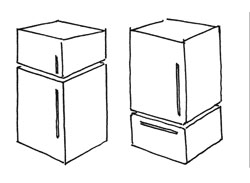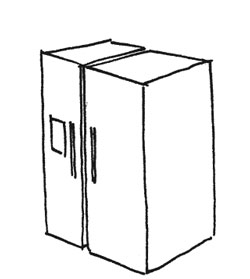Buying a New Refrigerator
Because efficiency has improved so rapidly, if your refrigerator is old, needs repairs, or is nearing the end of its expected 15-year life, it makes good economic sense to replace it before it fails on you.
For full-size refrigerators, ENERGY STAR units will use at least 10% less electricity than units meeting new minimum efficiency standards, often at no additional first cost. And some models even use 20% less electricity. We recommend that you consider models that are at least 10% better than the federal standard. More efficient models may qualify for rebates — check with your local utility.
The ENERGY STAR program also covers compact refrigerators. Compact refrigerators less than 7.75 ft3 must be 10% more efficient than the minimum federal standard to qualify, but there are many models that exceed the standards by 25% or more. More on the economics of owning a second refrigerator is discussed below.
Configuration and Features
When shopping for a new refrigerator, it is important first to consider what style and features you want, and what the energy penalties can be. For example, side-by-side refrigerator/freezers use more energy than similarly sized models with the freezer on top, even if they both carry the ENERGY STAR. Icemakers and through-the-door ice also add to energy consumption. Unfortunately, it can be difficult to compare energy performance across different refrigerator types. The yellow EnergyGuide label and the ENERGY STAR program compare energy use among models with the same configuration within a narrow range of sizes. To compare models with different configuration or features, check the annual kWh per year or operating cost value displayed on the EnergyGuide label of each model of interest to you. ACEEE's partner, Enervee, makes this even easier: check out the Enervee Marketplace for an easy way to compare models by features, expected energy costs, purchase price, and utility rebates. Don’t rely on the ENERGY STAR label alone when selecting a refrigerator — a top freezer model that does not qualify for ENERGY STAR may actually use less energy than an ENERGY STAR labeled side-by-side of comparable size and features. Proposed revisions to the ENERGY STAR refrigerator and freezer specification would begin to address some of these shortcomings.
Comparison of Energy Use across Refrigerator Types
| Refrigerator Type | Total Capacity (ft3) | Fridge Capacity (ft3) | Freezer Capacity (ft3) | Energy Use (kWh/year) |
|---|---|---|---|---|
| Least Efficient Models | ||||
| Top Freezer | 21.9 | 15.5 | 6.4 | 529 |
| Bottom Freezer | 22.4 | 15.6 | 6.8 | 582 |
| Side by Side | 22.1 | 14.3 | 7.8 | 679 |
| ENERGY STAR Models | ||||
| Top Freezer | 21.7 | 15.2 | 6.5 | 422 |
| Bottom Freezer | 22.4 | 15.6 | 6.8 | 465 |
| Side by Side | 22.6 | 14.1 | 8.5 | 550 |
| Most Efficient Models | ||||
| Top Freezer | 21.3 | 15 | 6.1 | 364 |
| Bottom Freezer | 21.9 | 15.6 | 6.3 | 403 |
| Side by Side | 21.9 | 14.8 | 7.1 | 438 |
Note: All models compared here have icemakers; side-by-side models have through-the-door ice dispensers.
If maintained well (to minimize frost buildup, see the section on boosting efficiency), manual defrost models use less electricity than automatic defrost models. However, they are not widely available. Built-in designer refrigerators may also consume more energy than store models, but are less wasteful than they used to be since the national appliance energy standards took effect.
Size
Size matters, too. Generally, the larger the unit, the greater the energy consumption. Too large a model will result in wasted space and energy; too small a model could mean extra trips to the supermarket. There is overlap between sizes, so it makes sense to compare. For example, you may find an efficient 18 ft3 model that costs less to run than a 15 ft3 model with similar features.
Keep in mind that the labeled capacity of the refrigerator may not correspond well to the actual usable space. A smaller top or bottom freezer model may actually have the same or more usable storage space than a larger side-by-side model, particularly in the refrigerator section.
Ready to Buy? Check out the Enervee Marketplace
ACEEE’s partner, Enervee, makes it simple to find the best deals from your favorite retailers on the most energy efficient refrigerators that meet your needs.
Installing Your Refrigerator
If possible, locate refrigerators and freezers away from heat sources and direct sunlight. In the kitchen, try to keep your refrigerator away from the dishwasher and oven. Allow at least 1" space on each side of a refrigerator or freezer to allow good air circulation. Freezers can be installed in an attached garage or basement, which will boost energy performance somewhat during cooler months and reduce cooling loads in your house somewhat during the warmer months. However, don’t put a refrigerator or freezer in a space that frequently goes below 45° — the refrigerant will not work properly.
Owning a Second Refrigerator
If you are thinking of buying a second refrigerator, or keeping your old one for extra storage when you get a new unit, you might want to reconsider. It is generally much less expensive to buy and operate one big refrigerator than two small ones. If the extra refrigerator is an old model, it’s probably an energy guzzler. If you only need a second refrigerator a few days a year or to hold a few six-packs of beer, why spend an extra $100 per year in electricity? If you need a second refrigerator for convenient beverage and snack storage in a family room, consider an ENERGY STAR-rated compact refrigerator. If you have a freezer or second refrigerator that’s nearly empty, turn it off. You’ll do no harm to your refrigerator or freezer by turning it on and off periodically.
Cost of Owning a Second Refrigerator
| Buying one large refrigerator | Buying a second compact fridge | Keeping your old fridge in the basement | |
|---|---|---|---|
| New ENERGY STAR Refrigerator (25 ft3)* | New ENERGY STAR Refrigerator (20 ft3) + MiniFridge (5 ft3) | Your Old 1994 Refrigerator (25 ft3) | New ENERGY STAR Refrigerator (20 ft3) |
| 617 kWh/year | 805 kWh/year | 704 kWh/year946 | kWh/year |
| $80 per year | $104 per year | $163 per year | $163 per year |
Assumes 11.9¢/kWh for electricity. Bottom-freezer models are available in larger sizes than top-freezer models.
Buying a New Freezer
There are two basic freezer styles: upright (front loading) and chest (top loading). Chest freezers are 10–25% more efficient than uprights because they are better insulated and air doesn’t spill out when the door is opened. The current standard for freezers went into effect in September 2014. Look for ENERGY STAR to identify energy-efficient models. To qualify, full-size and compact freezers must use at least 10% less electricity than the federal minimum standards. Manual defrost freezers are more common than automatic defrost models, and they tend to do a better job at storing food. (Automatic defrost freezers may dehydrate frozen foods, causing freezer burn.) Because a stand-alone freezer is opened less frequently than a refrigerator-freezer, frost will generally not build up as quickly as it might in a manual defrost refrigerator.
Ready to Buy? Check out the Enervee Marketplace
ACEEE’s partner, Enervee, makes it simple to find the best deals from your favorite retailers on the most energy efficient freezers that meet your needs.



